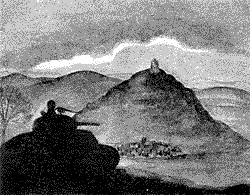|
|
|
|
V The Fight for Monte Cassino Abbey |
|
 All attempts of the 34th Division on our right to
capture the stronghold of Cassino had been unsuccessful. Nonetheless they had succeeded in
capturing the northern end of the valley formed by the eastern rim of the low ground and
were occupying a salient in the Mount Caira-Cassino ridges along with a few houses in the
outskirts of Cassino at the northwest entrance to the town. The enemy, however, was firmly
entrenched along the southern and western heights, holding Mount Cassino. The historically
famed Abbey of Mount Cassino, home of the Benedictine Monks, straddled the very tip of the
mountain, commanding the eastern and southern approaches to the ancient village at its
base. All attempts of the 34th Division on our right to
capture the stronghold of Cassino had been unsuccessful. Nonetheless they had succeeded in
capturing the northern end of the valley formed by the eastern rim of the low ground and
were occupying a salient in the Mount Caira-Cassino ridges along with a few houses in the
outskirts of Cassino at the northwest entrance to the town. The enemy, however, was firmly
entrenched along the southern and western heights, holding Mount Cassino. The historically
famed Abbey of Mount Cassino, home of the Benedictine Monks, straddled the very tip of the
mountain, commanding the eastern and southern approaches to the ancient village at its
base.The Germans had occupied the Abbey, using it for observation and defense. Possession of this virtually inaccessible bastion rendered success of any tactical movements through the low ground to the south extremely unlikely. The only means of circumventing this enemy advantage lay in the capture of the edifice by storming the heights or rendering it untenable by reduction to rubble through the use of siege guns and destructive bombings. While the Allied world debated the propriety of the destruction of this ancient shrine, our forces pursued the plan of capturing it without reduction, suffered considerable casualties — and attained no success. Each day of combat was reduced to its simplest components of slugging it out with the enemy while separated from him by no more than a door, a wall, a pile of rubble, the length of a bayonet — the simple measure of battle that spans the narrow way between the living and the mute companionship of death. "How are things going?" we asked a haggard leader of a squad who had spent more than 20 days in the embattled ruins of Cassino. He replied in a colorless, low monotone, his voice betraying an ageless weariness. Only in his eyes was there the least flicker of his wry emotion. "We have a line which occupies one room in the Continental Hotel. With the moral support of the people back home who don't want the Abbey destroyed, and at the bloody price of several more of their sons, we are gonna push our outposts into the kitchen." On February 8, 1944, we received notice that we would move to the vicinity of Caira, a village at the base of the 34th Division's salient, relieve elements of that Division, and join other elements of these famed "Red Bull" men in a coordinated effort to unseat the enemy from the Mount Cassino ridge, envelope the Abbey from the north and east, and capture it by infantry assault. The relief was accomplished by the night of February 9-10th. The road to Caira was a tortuous trail of mud and eroded ditches. The only means of access to the town and the salient which had been secured in the mountains involved working north along the eastern rim of the valley from San Vittore through Cervarro and San Michele to Portella, and then doubling back toward the southwest into the valley. The route then turned south along the eastern edge of' the low land, almost to Cassino itself, cut west across the valley floor, crossing the Rapido near the Italian barracks at Villa, and finally north along the base of the mountain mass into Caira. The continuous rains of February 8-11th had loosened the soft surface of the roads and rendered them almost impassable. Some sections had a foot of mud on their surface. The entire route from Cervarro was under clear observation from the Abbey, and many points, particularly the crossroads, were impact areas subjected to accurate enemy artillery concentrations. Where the route passed across the floor of the valley, it was virtually under the towering observation posts the enemy maintained in the Abbey and surrounding heights.
|
|
Copyright © 1945, 1998 141st Infantry Regiment
Association. |
